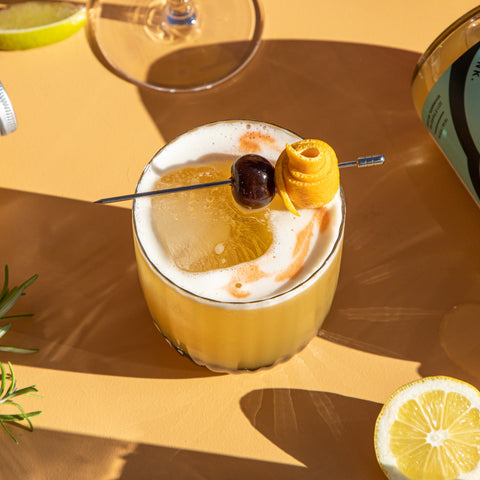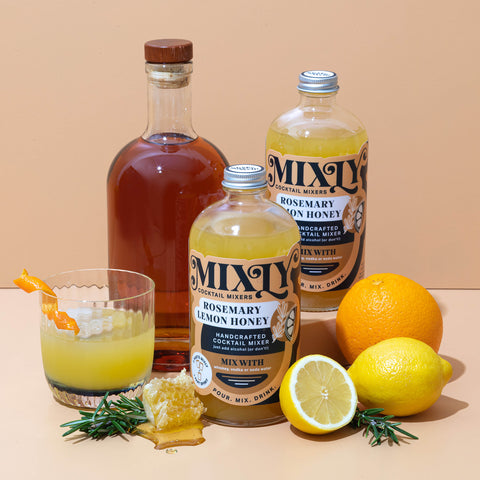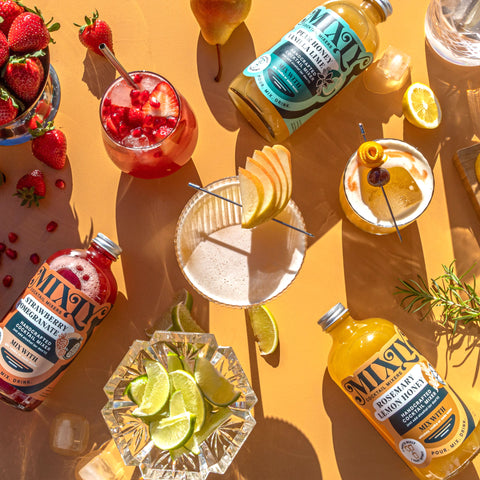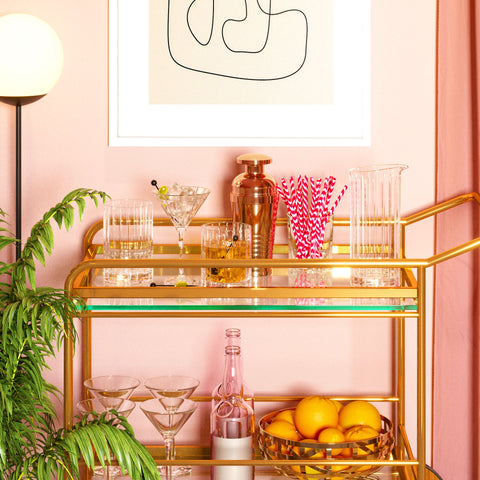Cocktail bitters are a necessary ingredient in many cocktails. In fact, they're often considered the bartender's secret weapon. Whether you're a professional bartender or an at-home connoisseur, bitters should be at the top of your list when building your ultimate mixology toolkit.
But what exactly are cocktail bitters? How do they taste? How do you use them? And where can you buy them?
If these questions are at the top of your mind, you've come to the right place. Let's get all your questions about cocktail bitters answered—let's dive in!
What Are Cocktail Bitters?
An excellent way to think about cocktail bitters is to equate them to your favorite seasoning, as the salt and pepper of the mixology world. But instead of seasoning for food—they're seasoning for cocktails! While certain types of bitters can be helpful in baking and other cooking recipes, we're going to focus on their important position in the bartending world.
So, what are cocktail bitters? They're high-proof spirits infused with various herbs and spices for flavoring cocktails at their core. Bitters can add delicious depth and complexity to any cocktail with a few quick dashes. They're imperative for successful modern mixology.
The complexity they add to drinks comes from the multitude of botanicals they contain—they typically have their own unique flavor that isn't 100% recognizable or easy to define.
What Ingredients Are In Cocktail Bitters?
Some of the most famous brands keep their recipes a mystery, and each different variation comes with its unique batch of herbs and spices. Some of the commonly used ingredients are herbs, spices, tree bark, fruit rind, roots, and the list goes on. Frequent flyers are gentian root, cascarilla, orange peel, and cassia bark.
You may also hear about bitter Italian liqueurs known as Amaro, Italian for bitter. These liqueurs contain an exciting array of herbs, spices, and funky botanicals like cocktail bitters. While these differ from the cocktail bitters we're discussing; we'll take a quick look at them later in this post.
Are Cocktail Bitters Alcoholic?
Essentially, yes. Most bottles of cocktail bitters will state they're 35-45% alcohol by volume (ABV) on their label, which is relatively high. However, they're used so sparingly in cocktail recipes that their alcoholic component doesn't end up having much of an effect.
Most cocktail recipes only call for a few dashes of bitters for reference. If you add two dashes (which translates to about ¼ of a teaspoon), the alcohol content falls to about 0.01%.
How Do You Use Cocktail Bitters In A Drink?
Using cocktail bitters is a straightforward process. All you have to do is add a few dashes as you build your cocktail! Remember when we mentioned cocktail bitters being like salt and pepper in cooking? Think of it like that. Most recipes state, "a pinch of salt" or "add fresh pepper to taste." Applying those exact directions when adding cocktail bitters to drinks is a safe way to start.
Nowadays, thanks to the Cocktail Renaissance, the world of cocktail bitters is blossoming right alongside the craft cocktail scene. Drinks, such as the Trinidad Sour, use bitters in entirely new ways. If you're feeling adventurous, play around! At the end of the day, it's what tastes best for your palate or the palate of those you're serving. And who knows? Maybe you'll be the next person to reinvent their use!
What Are The Most Popular Cocktail Bitters?
If you're new to the world of cocktail bitters, there are a few essential varieties to know. Angostura bitters, orange bitters, and Peychaud bitters are three classic flavors used for hundreds of years.
Angostura Bitters
Angostura bitters are the most popular components of well-loved classical cocktails such as the Old Fashioned or the Manhattan. They're made in Trinidad and Tobago at the House of Angostura and date back to 1824.
Dr. Johann Siegert created Angostura's aromatic bitters in 1824 for medicinal purposes—a tincture known (even today) to help soothe sore stomachs. When Dr. Siegert's sons migrated to Trinidad in the 1870s, they built the brand that solidified the aromatic bitters as an essential component in the food and cocktail scene. In the words of House of Angostura, the "aromatic bitters are today a staple for bartenders and cocktail enthusiasts, professional and home cooks alike, bounded only by the creativity and imaginations of those who use it."
What do Angostura bitters taste like?
While the exact recipe remains closely guarded, the flavor profile contains gentian, clove, and cinnamon notes for a bitter, subtle spice.
Peychaud Bitters
Have you ever heard of a cocktail called the Sazerac? Well, Peychaud bitters are its flavor foundation. In the 1830s, Antoine Peychaud first produced the bitters in his New Orleans apothecary. Like many first uses of cocktail bitters and tinctures, he offered his creation to his customers to remedy various ailments by combining the bitters with water, sugar, and French brandy.
In 1857, newspaper records showed advertisements that Peychaud's bitters were put into the original Sazerac Coffeehouse. And as Sazerac House claims, this is how his bitters connected to the origins of the Sazerac cocktail (now the official drink of New Orleans).
What do Peychaud's bitters taste like?
Peychaud's is lighter and sweeter than Angostura bitters. Its flavor profile contains cherry, clove, orange, anise, and mint notes.
Orange Bitters
The base of orange bitters is, you guessed it, orange peels! Another classic flavor in cocktail making dates back to the 1860s when used in cocktails like the first dry martini recipe. While they fell off the map for a while, they've made an impressive comeback. Many brands, like Angostura, create unique variations.
What do orange bitters taste like?
Every company that produces orange bitters has its own unique recipe. That said, the commonly found flavor notes are citrusy (from the orange peel), along with more subtle flavors hinting at cardamom, anise, coriander, and cinnamon.
Other Cocktail Bitter Flavors
Nowadays, cocktail bitters come in almost any flavor you can think of. Several emerging bitters brands and distillers are coming out with unique lines of bitters that range from celery to chocolate to rhubarb.
Bitter Liqueurs
Like Angostura and Peychaud's, cocktail bitters are necessary for several classic cocktail recipes, but sometimes we don't have them on hand. And sometimes, we want to think outside the box! Leveraging bitter liqueurs can provide a good substitute for cocktail bitters.
Here are a few ideas:
- Campari: If you've had Campari, you know it's incredibly bitter, with a slight touch of sweetness. Campari is an Italian liqueur used in many classic drinks, like the Negroni, and is easy to track down. If you want to try subbing it in for cocktail bitters, try using about ¼ of a teaspoon.
- Fernet Branca: Fernet is an Italian Amaro, or herbal bitter liqueur. It has a deeper savory flavor than Campari and adds an exciting note to many cocktails. If you want to use it as a bitters substitute, adding in ¼ of a teaspoon is always a safe bet.
- Absinthe: Absinthe is a green liqueur that tastes like black licorice. It's a staple ingredient in classic cocktails like the Sazerac and is often used as "rinse" in many mixology inspirations. Keeping on the same trend, try dropping ¼ teaspoon of absinthe into your cocktail to explore another unique cocktail flavoring.
Where Can I Buy Cocktail Bitters?
Cocktail bitters are, surprisingly, easy to track down. Your local grocery store may even carry a few versions, especially Angostura. Cocktail bitters genuinely are a staple in both the food and drink world. If your local store doesn't have them, try visiting a liquor store or ordering them online. You'll find numerous brands and flavors online, along with options suitable for any budget. Happy exploring!
Cocktail Recipes That Use Bitters
Ready to try out a few recipes utilizing cocktail bitters? Check out a few standard recipes below! Or get creative and invent something new. Whatever route you choose, these recipes are a perfect way to get inspired.
While many modern cocktail-makers create their spin on these classics, the recipes below contain the common standards.
Old Fashioned Recipe
To make an Old Fashioned, you'll need sugar, Angostura bitters, water, bourbon, and an orange peel. You can also dash in orange bitters for enhanced flavor.
- Add ½ teaspoon of sugar (or a sugar cube) and bitters to the bottom of a rock's glass.
- Add a splash of water (about one teaspoon) and stir until the sugar almost dissolves.
- Fill your glass with ice.
- Add in two ounces of bourbon and stir to combine.
- Express an orange peel over the top (squeeze the peel to release the oils) and drop it in.
- Sip and enjoy!
Manhattan Recipe
A Manhattan cocktail recipe calls for rye whiskey, sweet vermouth, Angostura bitters, orange bitters, and brandied cherries or lemon peel for garnish.
- Add two ounces of rye whiskey, one ounce of sweet vermouth, two dashes of Angostura, and one dash of orange bitters to a mixing glass.
- Add ice and stir.
- Strain into a chilled glass and finish with your preferred garnish.
- Simple as that—enjoy!
Sazerac Recipe
The classic New Orleans cocktail combines absinthe, one sugar cube, water, Peychaud's bitters, Angostura bitters, and rye whiskey or cognac.
- Add a small amount of absinthe into a rock's glass.
- Spin the glass to rinse it with the absinthe thoroughly. Discard any excess and place the glass to the side.
- In a mixing glass, add one sugar cube, ½ teaspoon of water, three dashes of Peychaud's, and two dashes of Angostura.
- Muddle the ingredients until well combined.
- Then add in 2 ounces of rye or cognac and ice.
- Stir until chilled.
- Strain into your absinthe-rinsed glass and garnish with a twist of lemon.
- Sip and enjoy the New Orleans classic cocktail!
Trinidad Sour
We mentioned this recipe above, so we had to offer the recipe too! This recipe is unique because it utilizes Angostura bitters as the main component (instead of a few simple dashes). This cocktail is a great place to start if you're feeling adventurous.
You'll need Angostura bitters, rye whiskey, lemon juice, and orgeat (a syrup made of almonds, sugar, and orange flower water).
- Add 1.5 ounces of Angostura bitters, 0.5 ounces of rye whiskey, 0.75 ounces of lemon juice, and 1 ounce of orgeat to a cocktail shaker.
- Add ice and shake.
- Double strain into a glass without ice.
- Garnish with a lemon twist.
- Enjoy!
Pick up a few bottles of cocktail bitters today and start exploring! If you want an extra dose of inspiration, build a cocktail with one of Mixly's mixers, dash in some cocktail bitters and impress your guests with mixologist-approved libations. Happy mixing!




